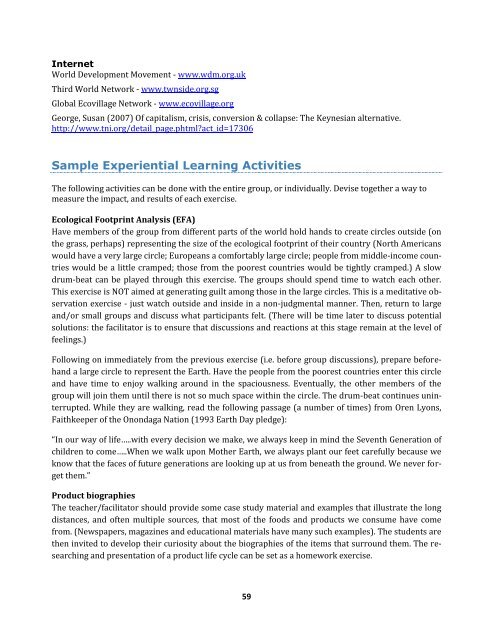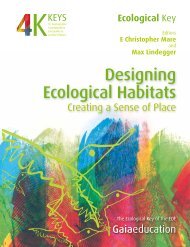EDE Curriculum 2012.pdf - Gaia Education
EDE Curriculum 2012.pdf - Gaia Education
EDE Curriculum 2012.pdf - Gaia Education
Create successful ePaper yourself
Turn your PDF publications into a flip-book with our unique Google optimized e-Paper software.
Internet<br />
World Development Movement - www.wdm.org.uk<br />
Third World Network - www.twnside.org.sg<br />
Global Ecovillage Network - www.ecovillage.org<br />
George, Susan (2007) Of capitalism, crisis, conversion & collapse: The Keynesian alternative.<br />
http://www.tni.org/detail_page.phtml?act_id=17306<br />
Sample Experiential Learning Activities<br />
The following activities can be done with the entire group, or individually. Devise together a way to<br />
measure the impact, and results of each exercise.<br />
Ecological Footprint Analysis (EFA)<br />
Have members of the group from different parts of the world hold hands to create circles outside (on<br />
the grass, perhaps) representing the size of the ecological footprint of their country (North Americans<br />
would have a very large circle; Europeans a comfortably large circle; people from middle-income countries<br />
would be a little cramped; those from the poorest countries would be tightly cramped.) A slow<br />
drum-beat can be played through this exercise. The groups should spend time to watch each other.<br />
This exercise is NOT aimed at generating guilt among those in the large circles. This is a meditative observation<br />
exercise - just watch outside and inside in a non-judgmental manner. Then, return to large<br />
and/or small groups and discuss what participants felt. (There will be time later to discuss potential<br />
solutions: the facilitator is to ensure that discussions and reactions at this stage remain at the level of<br />
feelings.)<br />
Following on immediately from the previous exercise (i.e. before group discussions), prepare beforehand<br />
a large circle to represent the Earth. Have the people from the poorest countries enter this circle<br />
and have time to enjoy walking around in the spaciousness. Eventually, the other members of the<br />
group will join them until there is not so much space within the circle. The drum-beat continues uninterrupted.<br />
While they are walking, read the following passage (a number of times) from Oren Lyons,<br />
Faithkeeper of the Onondaga Nation (1993 Earth Day pledge):<br />
“In our way of life…..with every decision we make, we always keep in mind the Seventh Generation of<br />
children to come…..When we walk upon Mother Earth, we always plant our feet carefully because we<br />
know that the faces of future generations are looking up at us from beneath the ground. We never forget<br />
them.”<br />
Product biographies<br />
The teacher/facilitator should provide some case study material and examples that illustrate the long<br />
distances, and often multiple sources, that most of the foods and products we consume have come<br />
from. (Newspapers, magazines and educational materials have many such examples). The students are<br />
then invited to develop their curiosity about the biographies of the items that surround them. The researching<br />
and presentation of a product life cycle can be set as a homework exercise.<br />
59







